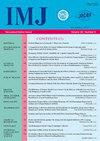HIV患者中枢神经系统感染性疾病的临床对照
Q4 Medicine
引用次数: 0
摘要
对451例HIV感染者病历的回顾性分析显示,脑结核最常见的临床表现为:头痛、发热≥38.0°C、脑膜症状;弓形虫病脑炎表现为头痛、脑神经和四肢麻痹、不协调、认知障碍、构音障碍、发烧≥38.0°C和抽搐;中枢神经系统真菌性病变包括头痛、协调障碍、脑膜阳性症状、意识障碍、认知障碍、视觉障碍、脑神经缺乏、抽搐和构音障碍。细菌性脑膜炎的临床表现以阳性脑膜症状、头痛、发烧、意识受损为主。同时,在中枢神经系统病变的神经系统表现中,如脑神经麻痹、单偏瘫、视觉、协调和言语障碍,多伴有脑弓形虫病、脑血管疾病、脑肿瘤、病因不明的脑炎。因此,分析表明,中枢神经系统病变的各种病因的临床表现往往是非特异性的,可能与脑组织的常见形态学变化有关,这可能与HIV的神经病理学影响以及大的影响共同感染有关。关键词:艾滋病病毒感染,机会性感染,中枢神经系统,主要症状。本文章由计算机程序翻译,如有差异,请以英文原文为准。
CLINICAL PARALLELS IN INFECTIOUS DISEASES OF THE CENTRAL NERVOUS SYSTEM IN PATIENTS WITH HIV
A retrospective analysis of medical records of 451 patients with HIV infection showed that the most common clinical manifestations of cerebral tuberculosis are as follows: headache, fever ≥ 38.0 °C, meningeal symptoms; in toxoplasmosis encephalitis these are headache, paresis of cranial nerves and extremities, incoordination, cognitive disorders, dysarthria, fever ≥ 38.0 °C and convulsions; in mycotic lesions of the CNS they are headache, coordination disorders, positive meningeal symptoms, disturbances of consciousness, cognitive disorders, visual disorders, cranial nerve deficiency, convulsions and dysarthria. The clinical picture of bacterial (exacted) meningitis was dominated by positive meningeal symptoms, headache, fever, impaired consciousness. At the same time, in such neurological manifestations of central nervous system lesions as cranial nerve paresis, mono− and hemiparesis, visual, coordination and speech disorders, which mostly accompany cerebral toxoplasmosis, cerebrovascular diseases, brain tumors, encephalitis of unspecified etiology. Thus, the analysis suggests that the clinical manifestations of various etiologies of lesions of the central nervous system are often nonspecific and probably are stipulated with common morphological changes in brain tissue, which may be associated with the neuropathological effects of HIV, as well as a large impact co−infection.
Key words: HIV infection, opportunistic infections, central nervous system, main symptoms.
求助全文
通过发布文献求助,成功后即可免费获取论文全文。
去求助
来源期刊

International Medical Journal
医学-医学:内科
自引率
0.00%
发文量
21
审稿时长
4-8 weeks
期刊介绍:
The International Medical Journal is intended to provide a multidisciplinary forum for the exchange of ideas and information among professionals concerned with medicine and related disciplines in the world. It is recognized that many other disciplines have an important contribution to make in furthering knowledge of the physical life and mental life and the Editors welcome relevant contributions from them.
The Editors and Publishers wish to encourage a dialogue among the experts from different countries whose diverse cultures afford interesting and challenging alternatives to existing theories and practices. Priority will therefore be given to articles which are oriented to an international perspective. The journal will publish reviews of high quality on contemporary issues, significant clinical studies, and conceptual contributions, as well as serve in the rapid dissemination of important and relevant research findings.
The International Medical Journal (IMJ) was first established in 1994.
 求助内容:
求助内容: 应助结果提醒方式:
应助结果提醒方式:


